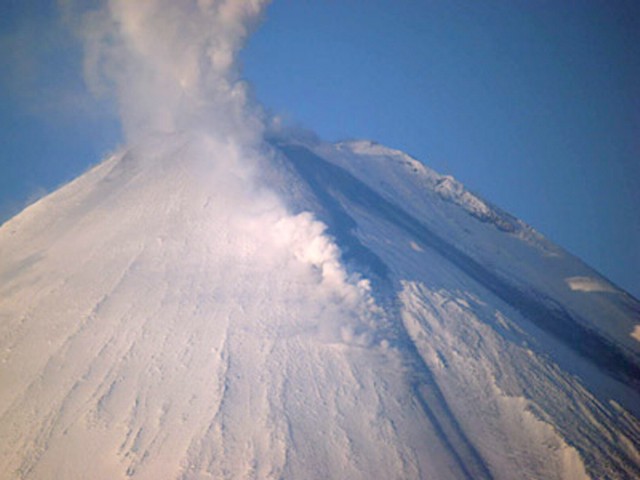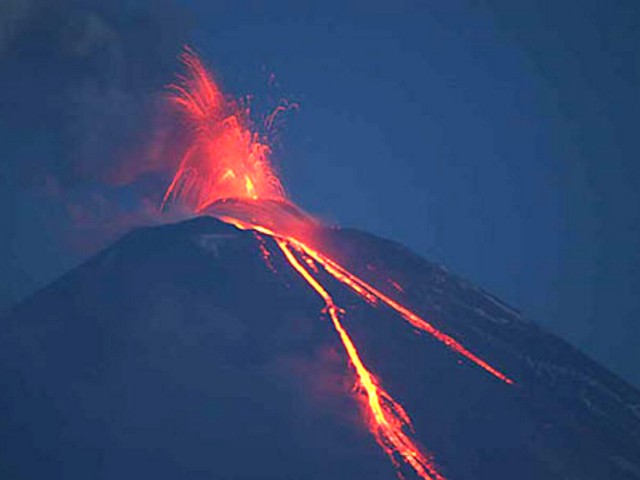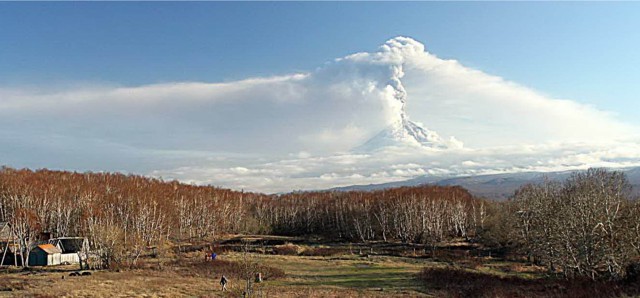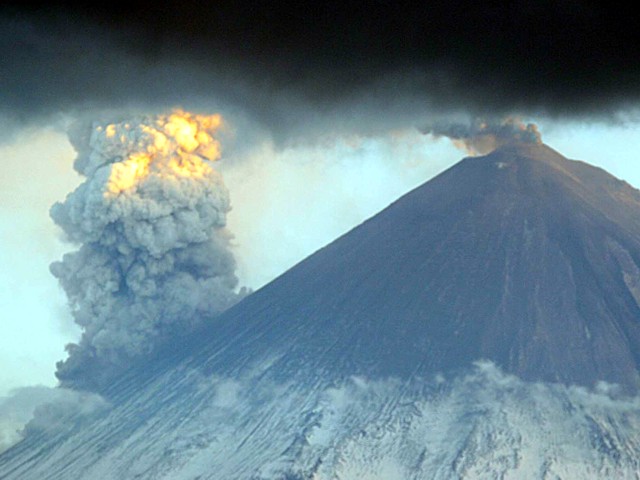Report on Klyuchevskoy (Russia) — June 2007
Bulletin of the Global Volcanism Network, vol. 32, no. 6 (June 2007)
Managing Editor: Richard Wunderman.
Klyuchevskoy (Russia) Significant eruptive activity resumes in mid-February 2007
Please cite this report as:
Global Volcanism Program, 2007. Report on Klyuchevskoy (Russia) (Wunderman, R., ed.). Bulletin of the Global Volcanism Network, 32:6. Smithsonian Institution. https://doi.org/10.5479/si.GVP.BGVN200706-300260
Klyuchevskoy
Russia
56.056°N, 160.642°E; summit elev. 4754 m
All times are local (unless otherwise noted)
Increased seismicity and volcanic activity began in January 2005 and continued through at least March 2005 (BGVN 30:03), with Strombolian eruptions, lava flows, ashfall, lahars, and tall steam plumes. Activity was intermittent during April 2005 through January 2007, primarily consisting of variable seismicity. Significant volcanic activity began again in mid-February 2007, after which large ash plumes became frequent and lava flows were observed. From that time through early August 2007 there have been Strombolian eruptions, lava flows, mudflows, and some large (though not particularly high) eruptive plumes extending up to ~ 2,000 km from the volcano, though cloudy weather often blocked views of the summit.
The seismic network maintained by the Kamchatka Experimental and Methodical Seismological Department (KEMSD) lacks a calibration linking ash-plume height with associated seismic signal. Instead, visual and video data were typically used by ground-based observers. Some height estimates cited here were based on satellite observations and comparisons with ancillary observations such as atmospheric wind profiles.
Activity during April 2005-January 2007. According to the Kamchatka Volcanic Eruptions Response Team (KVERT), ash-and-gas plumes rose to 1 km above the crater the first week of April. Eruptive and seismic activity decreased significantly on 7 April 2005, but remained above background levels until 8-9 May. During 8-15 July, seismicity again increased. This heightened activity continued through 15-22 July, with spasmodic volcanic tremor, shallow earthquakes, and gas-and-steam plumes rising to ~ 5.5 km above the crater. Ashfall was noted in Kozyrevsk on 22 June. On 22 July a weak ash-and-gas plume rose to ~ 100 m above the crater. This activity decreased in late July and returned to background levels by 3-9 August 2005. Weak fumarolic activity continued.
During 9-16 September, seismicity again increased. During this week, the amplitude of volcanic tremor increased, and weak gas-and-steam emissions and a thermal anomaly were visible on satellite imagery. By the middle of October 2005, activity had again returned to background levels where it apparently remained until December 2006. During the middle of December 2006, KVERT noticed a slight increase in seismicity, with moderate fumarolic activity. A thermal anomaly in the crater was detected on satellite imagery on 14, 15, and 18 December.
Activity during February-July 2007. Eruptive activity began again on 15 February 2007. Strombolian activity was observed during 15-18 February that ejected bombs 300 m above the crater. Video data and observations between 16 and 22 February indicated gas-and-steam plumes with small amounts of ash rising to altitudes of 5.3 km and drifting SW and then E. A thermal anomaly at the summit was detected during 16-19 and 21 February. Based on information from KEMSD and satellite imagery, the Tokyo Volcanic Ash Advisory Center (VAAC) reported that eruption plumes during 22-23 February may have reached altitudes of 6.1 km and drifted E. A news article in RIA Novosti cited local scientists who mentioned that on 26 February ash particles up to 2 mm in diameter fell on the village of Klyuchi, about 30 km NNE.
Clouds inhibited visual observations during most of February and March, but satellite data disclosed a daily thermal anomaly of 1-11 pixels in the crater area. Strombolian activity was seen again during 21-22 March, with lava bombs being ejected typically about 50-100 m above the crater; bomb heights of 100-200 m were noted on 31 March. On 29 March lava flowed down the NW flank.
A 23 March news report from RIA Novosti paraphrased Alexei Ozerov of the Russian Academy of Sciences in the department of Volcanology and Seismology, saying that activity had increased sharply since 15 February 2007. The article went on to quote Ozerov, stating that "The size of the lava globs reaches several meters in diameter." Geophysicists also reported through RIA Novosti that lava flows interacting with snow and ice were producing powerful explosions and vapor plumes.
KVERT reported that seismicity continued at heightened levels during April and May 2007. Volcanism over this period included Strombolian activity, lava flows down the NW flank, fumarolic activity, mudflows, and frequent gas-and-steam plumes with a small amount of ash that rose to altitudes of 5.3-6.3 km. Intensified fumarolic activity during 15-18 April resulted in higher gas-and-steam plumes, to altitudes of 6.3-7.2 km, possibly containing ash.
An ash plume drifting E on 22 April reached 8.8 km altitude. KVERT reported continuing mudflows and phreatic activity at lava flow fronts on the NW flank where lava interacted with ice (figure 4). Mudflows and lava flows advanced on the NW flank the following week, and plumes containing ash rose to altitudes of 5.2-7.2 km. Thermal anomalies were seen at the summit throughout April. Similar activity continued during the first half of May. Residents in Kliuchi heard explosions during 3-6 May, and reported ashfall on 4 May. Ash plumes that rose to 9.7 km on 11 and 16 May drifted E and NE, respectively, and again caused ashfall in Kliuchi. On 18 May KVERT reported that deposits from a mudflow filled the Krivaya river.
 |
Figure 4. Lava flows and mudflows on the NW flank of Kliuchevskoi, 22 April 2007. Courtesy of KVERT; photo by Yu. Demyanchuk. |
Ash plumes during 18-22 May rose to 8.5 km altitude, and Vulcanian summit activity and phreatic bursts on the NW flank were observed from 22 to 24 May. Strombolian activity at the summit built a new scoria cone that was visible on the night of 22 May, along with incandescent lava flows down the NW flank (figure 5). Strong eruptions occurred on 26 and 27 May, sending plumes to 10.1 km altitude on the latter day (figure 6). Ash plumes continued to be generated over the next few days, but only rose to 5-7 km altitude. A new lava flow moved down the E flank on 31 May, causing strong phreatic bursts (figure 7).
 |
Figure 5. Strombolian activity and a new scoria cone in the crater of Kliuchevskoi, 22 May 2007. Lava flows continued to move down the flanks. Courtesy of KVERT; photo by Yu. Demyanchuk. |
Heightened seismic and volcanic activity continued throughout most of June, with Strombolian and Vulcanian summit eruptions. Frequent ash plumes were often visible on satellite imagery, with estimated altitudes of 4.5-10 km. Plumes extended ~ 300 km S and E the entire week ending 8 June, and ~ 400 km N, W, and S the week ending 22 June. Increased seismicity on 19 June was followed by plumes and ashfall in Kozyrevsk village. A large ash cloud, ~ 300 km in diameter, was observed on 20-21 June near Yelizovo airport, 340 km S. On 29 June, ash plumes drifted E more than 2,000 km, while on 30 June, they drifted at least 900 km SW, based on satellite imagery. A thermal anomaly continued to be detected in the crater. Seismic activity decreased during 29 June-6 July, but remained above background levels through 13 July. Ash plumes visible on satellite imagery during 2-11 July rose to estimated altitudes of 5-7 km and drifted in various directions.
During 13-20 July, KVERT reported that seismic activity had returned to background levels, although a thermal anomaly in the crater and some ash plumes and gas-and-steam plumes were still noted. The hazard status had been either Orange or Red since mid-February, but toward the end of July the Level of Concern Color Code was lowered from Orange to Yellow due to a decrease in seismicity and an absence of ash plumes during 17-20 July. In a 9 August update, KVERT indicated that seismic activity had remained a background levels during the previous week, although some volcanic tremor and a few shallow earthquakes were registered. According to satellite data, a thermal anomaly was noted on 4 August (the volcano was obscured by clouds on other days).
Geological Summary. Klyuchevskoy is the highest and most active volcano on the Kamchatka Peninsula. Since its origin about 6,000 years ago, this symmetrical, basaltic stratovolcano has produced frequent moderate-volume explosive and effusive eruptions without major periods of inactivity. It rises above a saddle NE of Kamen volcano and lies SE of the broad Ushkovsky massif. More than 100 flank eruptions have occurred during approximately the past 3,000 years, with most lateral craters and cones occurring along radial fissures between the unconfined NE-to-SE flanks of the conical volcano between 500 and 3,600 m elevation. Eruptions recorded since the late 17th century have resulted in frequent changes to the morphology of the 700-m-wide summit crater. These eruptions over the past 400 years have originated primarily from the summit crater, but have also included numerous major explosive and effusive eruptions from flank craters.
Information Contacts: Olga Girina, Kamchatka Volcanic Eruptions Response Team (KVERT), a cooperative program of the Institute of Volcanic Geology and Geochemistry, Far East Division, Russian Academy of Sciences, Piip Ave. 9, Petropavlovsk-Kamchatsky, 683006, Russia (URL: http://www.kscnet.ru/ivs/eng/), the Kamchatka Experimental and Methodical Seismological Department (KEMSD), GS RAS (Russia), and the Alaska Volcano Observatory (USA); Alaska Volcano Observatory (AVO), cooperative program of the U.S. Geological Survey, 4200 University Drive, Anchorage, AK 99508-4667, USA (URL: http://www.avo.alaska.edu/), the Geophysical Institute, University of Alaska, PO Box 757320, Fairbanks, AK 99775-7320, USA, and the Alaska Division of Geological and Geophysical Surveys, 794 University Ave., Suite 200, Fairbanks, AK 99709, USA; Tokyo Volcanic Ash Advisory Center, Tokyo, Japan (URL: http://ds.data.jma.go.jp/svd/vaac/data/); RIA Novosti, Russian News and Information Agency, 4 Zubovsky Bulvar, 119021, Moscow, Russia (URL: http://en.rian.ru/).



